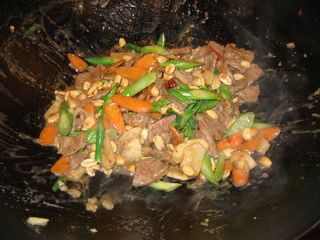It Isn’t Just About the Crunch

Fresh water chestnuts on a plate with gai lan, or Chinese flowering broccoli.
If you haven’t figured it out by now, I love shopping in Asian markets, particularly ones with well-stocked produce sections. Not only do they have innumerable types and varieties of greens for sale, but they also have many other delicious vegetables which many Americans have never tasted.
Such as fresh water chestnuts.
People who have never had a fresh water chestnut think that the entire purpose for the existence of them is to be crunchy, and sort of juicy. They think of them as pallid, flavorless little nuggets that come in cans, packed in tinny water which are added to various Chinese foods just to give them a jolt of crispness.
But that isn’t it at all that there is to them.
Water chestnuts are not a one-dimensional vegetable.
In their natural, uncanned state, they are delicious. Not only are they crisper than the canned sort, and juicier, they are intensely sweet. Uncooked, they taste sweeter than some varieties of apple, and stir fried, they are sublime, with a toothsome crunch and a subtle nutlike flavor.
Whenever I can get my hands on them, I buy them up and use them in whatever dish I am cooking, and when I teach Chinese cookery, I always try to have fresh water chestnuts on hand so that my students can taste the huge difference they make in foods. When I cannot get them, I substitute for them with jicama, a South American tuber that has a nearly identical texture, and a similar, though slightly starchier flavor.
I will no longer use canned water chestnuts, except under duress.
I lucked out this afternoon and found not only Thai basil, and Chinese flowering broccoli (gai lan) and beautiful pea shoots at the Chinese grocery, but also some fresh water chestnuts. Snagging up about a dozen of them, I tucked them gleefully in my shopping cart next to the Shanghai bok choy and skipped off down the aisle, my mind racing as I determined what to do with them.
I decided to use them in a version of kung pao beef with the gai lan and some carrots. The dish turned out looking very beautiful, with the jewel tones of the vegetables contrasting perfectly with the richly browned beef.

Kung Pao Beef from a recipe I found in Henry Chung’s Hunan Style Chinese Cookbook. The only thing I changed was the amount and type of vegetables used in the dish.
In order to pick out good water chestnuts, it helps if you can touch and smell them. They should either have little scent, or smell of the rich dark mud they grew in. If they are sold coated in mud, that is good–it helps to keep them fresh. The market where I buy them washes them thoroughly and packs them in little trays under plastic wrap. In that case, I poke at them and make certain they are quite firm and unyielding to the touch, and their skins are shiny, with some papery bits that are duller. There should be no evidence of mold or sliminess to water chestnuts at all.
Once you have them home, if they are muddy, give them a good soak in several changes of water, and then a gentle scrub with a vegetable brush to get all of the silt off of them. Then, using a very sharp paring knife, cut off the top and bottom, where the shoots and root ends are, and then carefully remove the peel in concentric circles. Work as slowly as you need to, so as to minimize wasting the flesh of the water chestnut by cutting too deeply.
After they are peeled, rinse them one more time and then you may cut them in whatever shapes you like. Have a taste of one before you use it to cook with, though I warn you–you will be tempted to keep eating them they are so good. But don’t do that–you would be very, very sad if you didn’t leave enough to put into Meyer Lemon Chicken or Chicken with Garlic Sauce or whatever other dish you feel like using them in.
I store the unused ones, still in their peels, in a paper bag in the fridge in the dry crisper drawer, not the humid one. They keep for up to a week, if they were really fresh to start out with. They don’t freeze well, but they do make tasty snacks, so if you find yourself unable to think of something else to put them in, slice them up and put them in salads, or just peel and eat them.
It will never do to waste a perfectly beautiful food like a fresh water chestnut.
2 Comments
RSS feed for comments on this post.
Sorry, the comment form is closed at this time.
Powered by WordPress. Graphics by Zak Kramer.
Design update by Daniel Trout.
Entries and comments feeds.



Hiya Barbara,
Very delectable dish, with all the textures, yum. I need to get my acts together and wing it. Just to get a feel, how much do the 12 waterchestnuts cost you? We have plenty of them here in Singapore, though I find that the quality is better during the mid-autumn months (Aug-Oct). The same goes for the muddy vegetables such as lotus root and “ling-jiao”. I boil it with sugar cane for a drink, I cook vegetarian with it, as well as dice it for my dumplings. Yes, I totally agree with you on the canned waterchestnuts. I have never tasted them, and I hope I won’t have to…ever! Shirley
Comment by Anonymous — March 7, 2005 #
Winging it is the most fun way to cook, in my opinion.
Here, the fresh water chestnuts are $1.19 a dozen. Not too bad, though way more expensive than canned. On the other hand, they taste so good, it is worth it to me to use them. (I hope you never have to taste them, either!)
I love lotus root, too. And taro root. Num.
Comment by Barbara Fisher — March 7, 2005 #